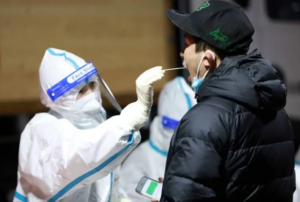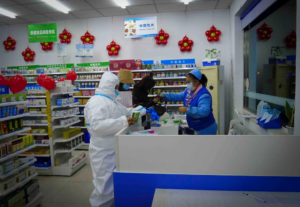
Anhui Province to optimize the epidemic prevention and control measures to make full use of the stockpile of therapeutic drugs and reagents
On December 21, the reporter learned from a press conference held by the Anhui Province New Crown Pneumonia Epidemic Prevention and Control Emergency Integrated Command Office that the province further optimized isolation control work and found that residents of the community with positive nucleic acid tests are no longer required to seal the floors, units and buildings where residents live. Close contacts of positive infected people can go to work normally and are no longer required to be under medical observation in isolation at home.
In the face of the rising number of new coronavirus infections, the rapid increase in demand for medical care and medication, the province, city and county up and down the linkage, strong and orderly to promote the implementation of optimal measures, medical resource preparation, medical supplies reserves, health management of key populations, vaccination of the elderly, etc., to maintain the province’s medical treatment order and the overall social situation continues to be stable, no serious cases of new coronavirus pneumonia and death for the time being.
Continuously optimize the epidemic prevention and control measures. The province further optimizes nucleic acid testing and inspection, advocating that the public “not necessary to do nucleic acid testing, not necessary to check the nucleic acid certificate”. In addition to nursing homes, orphanages, childcare institutions, primary and secondary schools and other places, for the convenience of the public, the province’s party and government organs at all levels, enterprises and institutions to take the lead, no longer check the nucleic acid negative certificate. All localities maintain the same layout, scale and efficiency of existing convenient nucleic acid sampling sites, rationalize sampling times and shifts, do a good job of sampling site epidemic prevention and control management, and facilitate nucleic acid testing for people who really need it.
Accelerate the preparation of medical resources. The province has set up 2,112 fever clinics (clinics), of which 658 medical institutions at the second level and above have achieved full coverage, and 1,554 of 1,612 community health service centers and township health centers have set up fever clinics (clinics), accounting for 96.4% of the total. In addition, a number of convenient fever clinics (consultation rooms) have been set up in various places, relying on Internet hospitals, square hospitals, sub-designated hospitals, village health offices, universities, large enterprises and squares, to further facilitate fever patients to seek medical treatment. The province’s new crown pneumonia designated hospital beds, ICU beds have reached the national requirements. To further strengthen the reserve of rescue beds, localities have relied on existing square cabin hospitals, health stations and other resources to upgrade and renovate a number of sub-designated hospitals to guarantee the demand for rescue and treatment of general cases. To ease the pressure of offline consultation, 51 Internet hospitals in the province opened online fever clinics to facilitate online consultation and effectively divert the pressure of offline fever clinics. All over the province, the family doctor service information and service guidelines are made public in a timely manner to facilitate the consultation of fever patients and the health management of home treatment personnel.
Effectively manage the health of key populations. Solidly carry out a survey of the health status of people over 65 years old, and according to the degree of risk marked red, yellow, green, classification and graded implementation of health monitoring, medical guidance, assistance in referral and other services. As of December 20, the province has fully completed the health survey of the elderly over 65 years of age, involving a total of 9,200,400 people, according to the age, whether the basic disease is stable, whether the new crown vaccination, etc., the initial determination of key population 1,164,100 people, accounting for 12.65%; secondary key population 2,026,000 people, accounting for 22.02%; general population 6,010,200 people, accounting for 65.33%.
Make full efforts to stockpile therapeutic drugs and reagents. Implementation of the elevated scheduling, the establishment of the provincial linkage mechanism with the executive vice governor as the convener, the provincial epidemic prevention office, economic and information, health, pharmaceutical supervision and other departments to strengthen the production of medical supplies reserves. Focusing on key drugs such as antipyretics, working groups were sent to key pharmaceutical enterprises to promote the production of pharmaceutical enterprises at full capacity, promote the resumption of production and expansion of qualified pharmaceutical enterprises, and promote the main role of pharmaceutical companies to ensure the supply of drugs in the province through multiple channels. Guiding local medical institutions to refine the placement plan and precise placement to protect patients’ drug needs. Organize Chinese medicine hospitals at all levels to produce Chinese medicine tonics and expand the alternative use of proprietary Chinese medicines.
Accelerate the preparation of medical resources. The province has set up 2,112 fever clinics (consultation rooms), of which 658 medical institutions at the second level and above have achieved full coverage, and 1,554 of 1,612 community health service centers and township health centers have set up fever clinics (consultation rooms), accounting for 96.4% of the total. In addition, a number of convenient fever clinics (consultation rooms) have been set up in various places, relying on Internet hospitals, square hospitals, sub-designated hospitals, village health offices, universities, large enterprises and squares, to further facilitate fever patients to seek medical treatment. The province’s new crown pneumonia designated hospital beds, ICU beds have reached the national requirements. To further strengthen the reserve of rescue beds, localities have relied on existing square cabin hospitals, health stations and other resources to upgrade and renovate a number of sub-designated hospitals to guarantee the demand for general case rescue and treatment. To ease the pressure of offline consultation, 51 Internet hospitals in the province opened online fever clinics to facilitate online consultation and effectively divert the pressure of offline fever clinics. Family doctor service information and service guidelines are made public in a timely manner throughout the province to facilitate the consultation of fever patients and health management of home treatment personnel.


Average Rating